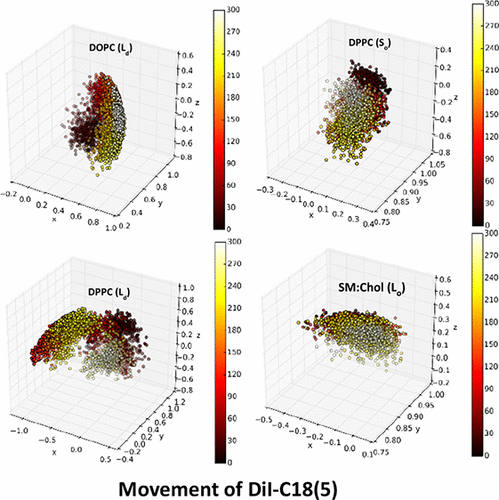Our official English website, www.x-mol.net, welcomes your
feedback! (Note: you will need to create a separate account there.)
Atomistic Picture of Fluorescent Probes with Hydrocarbon Tails in Lipid Bilayer Membranes: An Investigation of Selective Affinities and Fluorescent Anisotropies in Different Environmental Phases
Langmuir ( IF 3.7 ) Pub Date : 2018-07-07 00:00:00 , DOI: 10.1021/acs.langmuir.8b01164 S. Knippenberg 1, 2 , G. Fabre 3 , S. Osella 4 , F. Di Meo 5 , M. Paloncýová 1 , M. Ameloot 2 , P. Trouillas 5, 6
Langmuir ( IF 3.7 ) Pub Date : 2018-07-07 00:00:00 , DOI: 10.1021/acs.langmuir.8b01164 S. Knippenberg 1, 2 , G. Fabre 3 , S. Osella 4 , F. Di Meo 5 , M. Paloncýová 1 , M. Ameloot 2 , P. Trouillas 5, 6
Affiliation

|
By reverting to spectroscopy, changes in the biological environment of a fluorescent probe can be monitored and the presence of various phases of the surrounding lipid bilayer membranes can be detected. However, it is currently not always clear in which phase the probe resides. The well-known orange 1,1′-dioctadecyl-3,3,3′,3′-tetramethylindodicarbo-cyanine perchlorate (DiI-C18(5)) fluorophore, for instance, and the new, blue BODIPY (4,4-difluoro-4-bora-3a,4a-diaza-s-indacene) derivative were experimentally seen to target and highlight identical parts of giant unilamellar vesicles of various compositions, comprising mixtures of dipalmitoylphosphatidylcholine (DPPC), dioleoylphosphatidylcholine (DOPC), sphingomyelin (SM), and cholesterol (Chol). However, it was not clear which of the coexisting membrane phases were visualized (Bacalum et al., Langmuir. 2016,32, 3495). The present study addresses this issue by utilizing large-scale molecular dynamics simulations and the z-constraint method, which allows evaluating Gibbs free-energy profiles. The current calculations give an indication why, at room temperature, both BODIPY and DiI-C18(5) probes prefer the gel (So) phase in DOPC/DPPC (2:3 molar ratio) and the liquid-ordered (Lo) phase in DOPC/SM/Chol (1:2:1 molar ratio) mixtures. This study highlights the important differences in orientation and location and therefore in efficiency between the probes when they are used in fluorescence microscopy to screen various lipid bilayer membrane phases. Dependent on the lipid composition, the angle between the transition-state dipole moments of both probes and the normal to the membrane is found to deviate clearly from 90°. It is seen that the DiI-C18(5) probe is located in the headgroup region of the SM/Chol mixture, in close contact with water molecules. A fluorescence anisotropy study also indicates that DiI-C18(5) gives rise to a distinctive behavior in the SM/Chol membrane compared to the other considered membranes. The latter behavior has not been seen for the studied BODIPY probe, which is located deeper in the membrane.
中文翻译:

脂质双层膜中含碳氢化合物尾巴的荧光探针的原子图:不同环境阶段的选择性亲和力和荧光各向异性的研究
通过恢复光谱学,可以监测荧光探针的生物学环境的变化,并且可以检测周围的脂质双层膜的各种相的存在。但是,目前并不总是清楚探针位于哪个阶段。例如,众所周知的橙色1,1'-二十八烷基-3,3,3',3'-四甲基茚二碳-花青高氯酸盐(DiI-C18(5))荧光团,以及新的蓝色BODIPY(4,4-二氟-4-硼-3-一个,4一-diaza-小号从实验上观察到-(indacene)衍生物靶向并突出了各种组成的巨大单层囊泡的相同部分,包括二棕榈酰磷脂酰胆碱(DPPC),二油酰磷脂酰胆碱(DOPC),鞘磷脂(SM)和胆固醇(Chol)的混合物。然而,目前还不清楚其共存膜相的显现(Bacalum等人,朗缪尔。2016,32, 3495)。本研究通过利用大规模分子动力学模拟和z约束方法解决了这个问题,该方法可以评估吉布斯自由能谱。当前的计算结果说明了为什么在室温下,BODIPY和DiI-C18(5)探针都偏爱凝胶(S o)在DOPC / DPPC中的摩尔比(2:3摩尔比)和液体有序的(L o)相溶于DOPC / SM / Chol(摩尔比为1:2:1)的混合物中。这项研究强调了探针在荧光显微镜中用于筛选各种脂质双层膜相时,其方向和位置以及效率之间的重要差异。根据脂质的组成,两个探针的过渡态偶极矩与膜法线之间的夹角明显偏离90°。可以看到DiI-C18(5)探针位于SM / Chol混合物的头基区域,与水分子紧密接触。荧光各向异性研究还表明,与其他考虑的膜相比,DiI-C18(5)在SM / Chol膜中具有独特的行为。对于研究的BODIPY探针而言,后者的行为尚未见到,该探针位于膜的更深处。
更新日期:2018-07-07
中文翻译:

脂质双层膜中含碳氢化合物尾巴的荧光探针的原子图:不同环境阶段的选择性亲和力和荧光各向异性的研究
通过恢复光谱学,可以监测荧光探针的生物学环境的变化,并且可以检测周围的脂质双层膜的各种相的存在。但是,目前并不总是清楚探针位于哪个阶段。例如,众所周知的橙色1,1'-二十八烷基-3,3,3',3'-四甲基茚二碳-花青高氯酸盐(DiI-C18(5))荧光团,以及新的蓝色BODIPY(4,4-二氟-4-硼-3-一个,4一-diaza-小号从实验上观察到-(indacene)衍生物靶向并突出了各种组成的巨大单层囊泡的相同部分,包括二棕榈酰磷脂酰胆碱(DPPC),二油酰磷脂酰胆碱(DOPC),鞘磷脂(SM)和胆固醇(Chol)的混合物。然而,目前还不清楚其共存膜相的显现(Bacalum等人,朗缪尔。2016,32, 3495)。本研究通过利用大规模分子动力学模拟和z约束方法解决了这个问题,该方法可以评估吉布斯自由能谱。当前的计算结果说明了为什么在室温下,BODIPY和DiI-C18(5)探针都偏爱凝胶(S o)在DOPC / DPPC中的摩尔比(2:3摩尔比)和液体有序的(L o)相溶于DOPC / SM / Chol(摩尔比为1:2:1)的混合物中。这项研究强调了探针在荧光显微镜中用于筛选各种脂质双层膜相时,其方向和位置以及效率之间的重要差异。根据脂质的组成,两个探针的过渡态偶极矩与膜法线之间的夹角明显偏离90°。可以看到DiI-C18(5)探针位于SM / Chol混合物的头基区域,与水分子紧密接触。荧光各向异性研究还表明,与其他考虑的膜相比,DiI-C18(5)在SM / Chol膜中具有独特的行为。对于研究的BODIPY探针而言,后者的行为尚未见到,该探针位于膜的更深处。











































 京公网安备 11010802027423号
京公网安备 11010802027423号